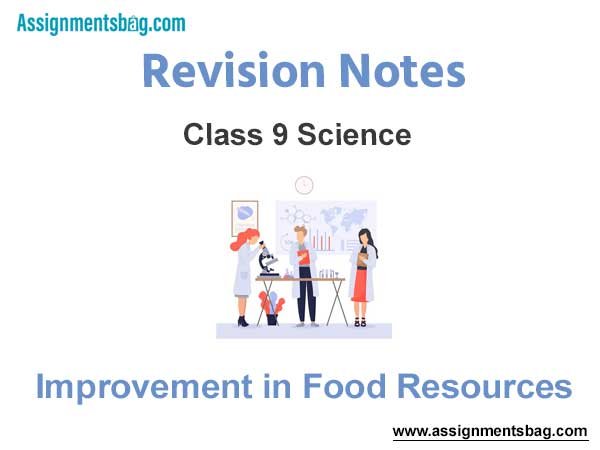Please refer to the Improvement in Food Resources Revision Notes given below. These revision notes have been designed as per the latest NCERT, CBSE and KVS books issued for the current academic year. Students will be able to understand the entire chapter in your class 9th Science book. We have provided chapter wise Notes for Class 9 Science as per the latest examination pattern.
Revision Notes Chapter 15 Improvement in Food Resources
Students of Class 9 Science will be able to revise the entire chapter and also learn all important concepts based on the topic wise notes given below. Our best teachers for Grade 9 have prepared these to help you get better marks in upcoming examinations. These revision notes cover all important topics given in this chapter.
Food Resources: Cereals (Wheat, rice, maize, millets and sorghum) provide us carbohydrates; Pulses (Grams, pea and lentil) provide us proteins; Oil seeds (Soya bean, ground nut, sesame, and castor) provide us fats; Vegetables, spices and fruits provide us a range of minerals, nucleic acids and vitamins. In addition to these food crops, fodder crops like berseem, oats or sudan grass are raised as food for the livestock are called as fodder crops.
The Kharif crops: The crops grown in rainy season are called as Kharif crops (Paddy, Soya bean, pigeon pea and maize). They are grown from June to October.
The Rabi crops: The crops grown in winter season are called Rabi crops (Wheat, gram, peas, and mustard). They are grown November to April.
Compare Kharif crops and Rabi crops:

The Green Revolution: Food supplies are generally as proteins, carbohydrates, fats, minerals, nucleic acids and vitamins in all living organisms. Indian population is growing enormously. Green Revolution is the need of the hour to increase food-grain production.
Sustainable Practices: For sustained livelihood, one should undertake mixed farming, intercropping, and integrated farming practices, for example, combining agriculture with
livestock/ poultry/ fisheries/bee-keeping. The major group of activities for improving crop yield can be classified as: Crop varietal improvement, Crop production improvement, Crop protection improvement
The Crop varietal improvement:
a) Hybridization: It refers to crossing between genetically dissimilar plants;It is all to get higher yield, improved quality, biotic and abiotic resistance, change in maturity duration, wider adaptability and desirable agronomic characteristics.

The Crop production improvement: They include” no cost production”,” low costproduction” or “high cost production” practices.
a) Nutrients( Sixteen elements are required for growth are called as essential elements Carbon, oxygen, hydrogen+ Macronutrients & Micronutrients. They increase the yield):

b) Manure & Fertilizers:

Irrigation: India has variety of water resources: Wells, canals, river lift system, tanks, rainwater harvesting, water shedding management to increase in ground water levels and to check the water flowing away to the sea. Planning to reduce soil erosion.
Cropping patterns:


Crop protection improvement/ management: Field crops are infested by large number of weeds, insects pests, diseases & storage of grains

Animal Husbandry: It is a scientific management of animal livestock, includes feeding, breeding and diseases control. Animal-based farming includes cattle farming, Poultry farming, fish farming, and bee Keeping.



Important Question and Answer :
Question. What is the importance of Bee Culture?
Answer
It is useful for honey, wax, medicinal preparations. And also for additional income to the farmer.
Question . Write about the importance of Green Revolution.
Answer
Indian population is growing enormously. Green Revolution is the need of the hour to increase food-grain production.
Question . Give two examples of Cereals .
Answer
Wheat, rice
Question . Define the term mixed cropping and give two examples.
Answer
Two or more crops grown simultaneously on the same piece of land Ex. Wheat+ Gram; Wheat+ Mustard
Question . Distinguish between weeds, insects pests.
Answer
Weeds are unwanted plants in the crop field Insect pest is nuisance in the crop field
Question . Define the Kharif crop and give two examples .
Answer
The crops grown in rainy season are called as Kharif crops Ex. Paddy, Soya bean
Question . What is Animal Husbandry?
Answer
It is a scientific management of animal livestock, includes feeding, breeding and diseases control. Animal-based farming includes cattle farming, Poultry farming, fish farming, and bee keeping.
Question . Define the term Hybridization.
Answer
Crossing between genetically dissimilar plants
Question . Distinguish between aquaculture and mariculture.
Answer
Fish production is aquaculture. Growing of marine fishes is called mariculture
Question . What is the importance of Genetically Modified Crops?
Answer
It is another way of improving the crop is by introducing a gene that would provide the desired characteristic.



